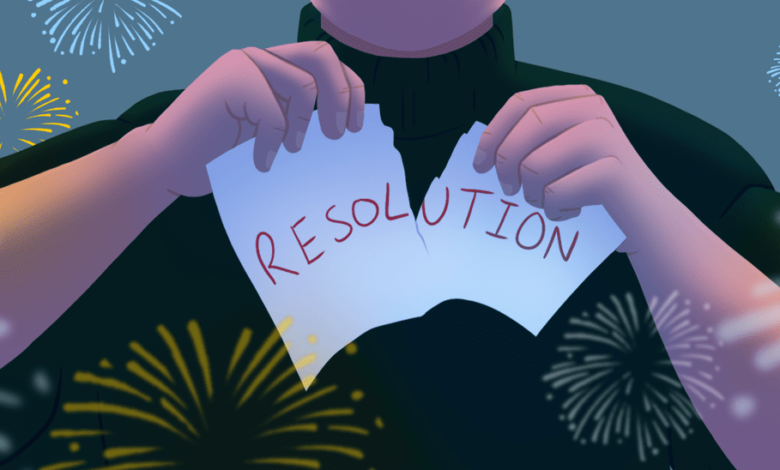The End of the Resolution

Evidence shows that New Year’s resolutions are made to be broken…and people are no longer making them. This year, Verywell Fit and Verywell Mind are taking a joint stance against the resolution and providing readers with actionable, evidence-based ways to make lasting changes that will serve our readers’ minds, bodies, and spirits well beyond 2023. Join us to learn how to optimize your wellness, one small step at a time.
In This Digital Issue:
If you do one thing in 2023, skip making a resolution. Typical fitness and nutrition brands promote a “New Year, New You” (cringe) or a “New Year, Better You” but we’re confident that you don’t need a rebrand. The resolution does.
Why are Resolutions Over?
The societal conversation has changed, and it seems that most people are no longer interested in making sweeping resolutions or commitments that end in broken self-promises. If you want to make a change in your life, you don’t have to wait until January 1st. Every day presents the opportunity to make small, positive changes in your life.
Because Verywell Fit is rooted in science, we took a closer look at various data points to determine why the sentiment surrounding resolutions has changed. Here’s what we discovered.
Resolutions Are No Longer Trending
Although resolutions once dominated water cooler talk and dinner table conversations, they don’t seem to be a trend in conversation anymore. In fact, Google trend research shows that the search for “New Year’s Resolutions” dropped off a dramatic cliff in 2016 and continues to fall. Last year’s interest was roughly ¼ of what it was in 2016. It appears people are no longer looking to the internet to tell them what they need to change.
Resolutions Are Made to Be Broken
Data shows that most resolutions are made to be broken. For those who do make resolutions, very few keep them. According to a Marist poll, roughly 50% of U.S. adults who made resolutions from 1995 to 2019 actually kept them.
This leads us to think: why would you make a promise to yourself that you end up breaking, especially if the probable result is disappointment (and some self-loathing)? Why would you feel compelled to set your aim on a goal when your chances of achieving it are so low?
For Those Who Want to Make Resolutions, Health and Happiness Are Key
Even if the data doesn’t support resolutions working, we will still support those that want to make them (we see you GenZ). In fact, according to the latest Economist/YouGov Poll, 2 in 5 younger adults planned to make resolutions in 2022. Of those, 23% wanted to “live healthier” and 21% wanted “personal improvement or happiness.”
The continuous thread, or main takeaway, here is the desire for positive lifestyle changes. That’s what Verywell Fit is all about. However, we’ve learned that in order to make lasting positive lifestyle changes, individuals usually need personalized goals with clear, actionable, small steps.
Resolutions May Perpetuate Diet Culture
In our opinion, the phrase “New Year’s Resolution” screams lose weight, exercise more, and you’re not enough as is. It inherently represents everything that Verywell Fit has made a conscious effort to step away from.
Last year, Verywell Mind performed a poll that showed that New Years’ Resolutions increase how often people worried or felt negatively about how their bodies looked. In fact, among those who felt negatively about their body, almost one in five people cited New Years’ Resolutions as worsening their struggle with body image. It’s interesting to point out that the same poll revealed that the youngest Americans, who we know are also most likely to make resolutions, are most likely to have negative perceptions of their bodies.
What’s the Difference Between Resolutions, Habits, and Goals?
- A resolution is considered a firm decision to do or not do something. It’s set in stone and very uncompromising. While the intention is clear, the restrictive nature of resolutions is limiting and often ends in measuring either success or failure.
- A habit is a regular practice. Habits, whether good or bad, intentional or unintentional, are basically repeated enough times to become automatic.
- A goal is the desired result, which usually requires repetitive behaviors (habits) to achieve. It’s important to differentiate a habit from a goal. Short-term goals, once achieved, can become a habit.
It’s likely that social media perpetuates these feelings of negative body image, and perhaps fuels, the need to create life-changing resolutions. The term “resolution” and the media surrounding this hashtag on social platforms imply that you need to do penance for any weight gained during the holidays or workouts skipped in favor of social engagements. At Verywell Fit, we encourage you to indulge mindfully and take rest when you need it.
What Are We Focusing on Instead?
This answer is simple: slowing down, encouraging mindfulness, and tailoring our goals to where we are now to get where we want to be. We’re looking at health through a different lens.
If losing weight is a goal for you, skip the scale and measure your “progress” by how you feel. Choose exercise that feels good to your body rather than just adding “workout” to your daily checklist. Find purpose in your actions and focus on building strong habits. It’s the small changes that add up over time.
We know, we know…this is easier said than done. In theory, a slower approach to achieving goals through habit change works. But what about in real life? In all reality, not one method works for everyone, and it may take some trial and error to figure out what works for you.
Be confident in the fact that science does support the shift from restrictive resolutions to small habit changes in order to achieve your goal.
Why a Habit Instead of Resolution? Aren’t They the Same Thing?
Resolutions and habits are not interchangeable. Why does this matter? The flexible, fluid, changeable, and less restrictive nature of using habits actually works, even if it may take longer. Verywell Mind editor-in-chief, Amy Morin advises that “Resolutions often aren’t measurable. People say things like ‘I want to get healthier,’ or ‘I want to be happier.’ But those are vague ideas and you can’t really tell if you’re making progress.”
Morin adds, “Resolutions are often too big. People want to lose a lot of weight or pay off a lot of debt and they give themselves a year to do it. Then, they put off working on those goals because there aren’t any short-term objectives.”
We agree that shorter, more reasonable goals are the ones to set your sights on. While making solid, consistent habits is challenging, evidence shows that you will be more likely to achieve your goals by taking smaller steps instead of implementing unrealistic, sweeping changes.
Resolutions are often too big. People want to lose a lot of weight or pay off a lot of debt and they give themselves a year to do it. Then, they put off working on those goals because there aren’t any short-term objectives.
How to Shift to Solid Habits This Year
If you want to build solid habits to achieve your goals, follow these steps:
- Choose a Goal
- Identify Your Why
- Make Your Goal SMART
- Implement Small Habit Changes
Choose a Goal
Resolutions typically lead to an overarching goal. With habit change, you can achieve the same goal that you were aiming for, but the approach will be different.
Select a long-term goal that you feel will add to your life in a positive way. An example of a common goal is “becoming more active.”
In theory, you could make a resolution to go to the gym five days a week at 6 am. While this may work for a short period of time, it’s likely unsustainable, and after a few days of sleeping in or sick kids, you may give up. Instead, connect to a deeper motivation and develop a clear path.
Identify Your Why
Resolutions are largely driven by willpower. When that willpower wanes, or a stimulus distracts you from the goal, poof! Say sayonara to your resolution.
Instead of relying on sheer willpower alone, identify a really clear, motivating force, or “why,” to drive habit change. This motivation will fuel you during times that feel challenging, and you may be more likely to achieve your end goal if there is a deeper connection to the end result.
What should your “why” be? That’s a question that only you can answer. There is no one right “why.” It will be different for everyone. It should be fairly simple to answer.
Your goal is to be more active? Ask yourself why. What’s the first thing that comes to mind? Perhaps you want to keep up with your grandkids. Alternatively, you want to feel your strongest, mentally and physically. Internalize that motivation, and even consider writing it down.
Morin adds, “When I know something is going to be hard to do, I write down a list of reasons why I should do it. Then, when I don’t feel like doing it, I read over the list and it motivates me to keep going.” Continually—and consistently—connecting to your “why” is a great way to ensure that your motivation remains.
Make Your Goal SMART
Once you identify the motivating factor behind your overall goal, use SMART goals to hone in on a specific and measurable path to achieving it.
If you’re not familiar, the SMART acronym stands for:
Specific: Your goal needs to answer the questions: Who? What? Where? When?
Measurable: Add time and any relevant measurements. Measuring a goal makes it easier to track progress and identify any areas that you may need help with.
Attainable: Start where you are. It’s great to think big (please do!), but setting a goal that is within your reach during a specific time frame (while pushing you slightly out of your comfort zone) is more realistic.
Relevant (and realistic): Be sure that your goal aligns with your why.
Time-bound: Create a deadline or specific timeframe.
Let’s look at the “becoming more active” example that we mentioned earlier. This is an open-ended goal. To make it SMART, you may want to break it down into smaller, more actionable goals. For example, perhaps you want to walk a certain distance each week, exercise for a certain number of minutes each day, log a certain number of steps, or compete in an organized race.
If running a 5K is a realistic goal for you, make a SMART goal to get there. An example of a SMART goal for an experienced runner may be, “I will run a sub-30-minute 5k race in May 2023 by following an 8-week training plan.”
Implement Small Habit Changes
Small habits add to big changes over time. “Start small” may seem like mundane, useless advice, but the additive nature of small habits is undeniable, and you can use these habits to achieve your SMART goal over time.
Whether it’s preparing your breakfast or lunch for the next day before you go to sleep, journaling for two minutes when you wake up, or drinking a glass of water before a cup of coffee, each positive habit can work towards a larger end goal.
For the runner wanting to complete a sub-30-minute 5k race, incorporating speed work once per week may be a small change, just as daily recovery practices may be an additive change. An example of a positive habit to help achieve this goal is active stretching for 5 minutes after each workout to improve flexibility and muscle recovery while reducing the risk of injury.
Once you’ve adopted a few small, positive habits, you’re likely to create lasting change. While habit change is also highly individualized [link to habit stacking article], here are a few examples of small habits that can work towards larger goals.
If you want to:
- Get Active: Schedule (literally block) 10 minutes of your day to take a walk, use an app to take a yoga class, or move in any way that feels right for you.
- Improve Your Nutrition: Select at least one night per week that you prioritize cooking at home.
- Lose Weight: Start by adding one nutritious snack such as plain greek yogurt with berries to your afternoon. This may prevent you from becoming overly hungry at dinnertime.
- Be More Mindful: Perform a five-minute guided meditation on an app while you are commuting.
These small shifts can become significant when repeated over time. Think of runners who train for marathons. They consistently devote time, energy, and effort to put in miles upon miles of practice. Runners typically follow a specific, time-bound training plan that slowly builds up over time, just like a habit, so that what may feel unattainable at first (26.2 miles) is eventually within reach.
Prepare for Setbacks and Priority Shifts
Paths to achieving behavior change are rarely linear. Prepare for setbacks and roadblocks. “Making mistakes is part of the process,” Morin advises. “So when you skip a few days at the gym or eat more than you intended, don’t declare yourself a failure. Talk to yourself with self-compassion and use it as an opportunity to learn more about yourself and how you can do better moving forward.”
Understand that habit change is not easy. And, while consistency is key, it’s not always realistic. When you stray from your plan, get right back to it, or figure out a new path forward.
Similarly, goals shift. Don’t be hard on yourself if you’ve made it halfway, but feel like you want to go in a different direction. For example, if you were aiming to compete in a 10K race, but that suddenly feels like too much, try the 5K.
A Word From Verywell
It’s ok, and recommended, to ask for help. When something is new or challenging, it’s usually helpful to seek advice from someone who has experience in the field. This can range from a friend or family member sharing their personal feedback, or consulting with a licensed professional such as a therapist, personal trainer, or registered dietitian. A different approach or perspective may be just what you need.




